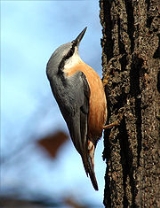
Nuthatch
Encyclopedia
The nuthatches are a genus
, Sitta, of small passerine
bird
s belonging to the family Sittidae
. Characterised by large heads, short tails, and powerful bills and feet, nuthatches advertise their territory using loud, simple songs. Most species exhibit grey or bluish upperparts and a black eye stripe.
Most nuthatches breed in the temperate or montane
woodlands of the Northern Hemisphere
, although two species have adapted to rocky habitats in the warmer and drier regions of Eurasia
. However, the greatest diversity is in Southern Asia, and similarities between the species have made it difficult to identify distinct species. All members of this genus nest in holes or crevices. Most species are non-migratory
and live in their habitat year-round, although the North America
n Red-breasted Nuthatch
migrates to warmer regions during the winter. A few nuthatch species have restricted ranges and face threats from deforestation
.
Nuthatches are omnivorous, eating mostly insect
s, nut
s and seed
s. They forage for insects hidden in or under bark by climbing along tree trunks and branches, sometimes upside-down. They forage within their territories when breeding, but may join mixed feeding flocks
at other times. Their habit of wedging a large food item in a crevice and then hacking at it with their strong bills gives this group its English name.
, 1758), a name derived from sittē, Ancient Greek
for this bird. Nuthatch refers to the propensity of some species to wedge a large insect or seed in a crack and hack at it with their strong bills.
Some taxonomists place the nuthatches, the Wallcreeper
and the treecreepers in a larger group with the wren
s and gnatcatcher
s. This superfamily
, the Certhioidea, is supported by phylogenetic
studies using mitochondrial and nuclear
DNA, and forms a sister clade
of the Sylvioidea
within the passerine birds. The fossil record for this group is restricted to a foot bone of an early Miocene
bird from Bavaria
, Certhiops rummeli, which has been identified as an extinct member of the Certhioidea clade.
Species boundaries in the nuthatches are difficult to define. The Red-breasted Nuthatch, Corsican Nuthatch
and Chinese Nuthatch have breeding ranges separated by thousands of kilometres, but are similar in habitat preference, appearance and song. They were formerly considered to be one species, but are now normally split into three and comprise a superspecies
along with the Krüper's
and Algerian Nuthatch
. Unusually for nuthatches, all five species excavate their own nests. The Eurasian
, Chestnut-vented
, Kashmir
and Chestnut-bellied Nuthatch
es form another superspecies and replace each other geographically across Asia. They are currently considered to be four separate species, but the south-Asian forms were once believed to be a subspecies of the Eurasian Nuthatch. A recent proposed change in this taxonomy is a split of the Chestnut-bellied Nuthatch into two species, namely the Indian Nuthatch, Sitta castanea, found south of the Ganges, and the Chestnut-bellied Nuthatch sensu strictu, S. cinnamoventris, which occurs in the Himalayas
.
The Nuthatch Vanga
of Madagascar
(formerly known as the Coral-billed Nuthatch) and the sitella
s from Australia
and New Guinea
were once placed in the nuthatch family because of similarities in appearance and lifestyle, but they are not closely related. The resemblances arose via convergent evolution
to fill an ecological
niche.
A 2006 review of Asian nuthatches suggested that there are still unresolved problems in nuthatch taxonomy and proposed splitting the genus Sitta. This suggestion would move the red- and yellow-billed south Asian species (Velvet-fronted
, Yellow-billed
and Sulphur-billed Nuthatch
es) to a new genus, create a third genus for the Blue Nuthatch
, and possibly a fourth for the Beautiful Nuthatch
. Mitochondrial DNA studies have demonstrated that the white-breasted northern subspecies of Eurasian Nuthatch, S. (europea) arctica, is distinctive and also a possible candidate for full species status.
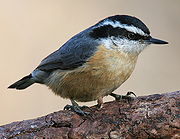 Nuthatches are compact birds with short legs, compressed wings, and square 12-feathered tails. They have long, sturdy, pointed bills and strong toes with long claws. Nuthatches have blue-grey backs (violet-blue in some Asian species, which also have red or yellow bills) and white underparts, which are variably tinted with buff, orange, rufous or lilac. Although head markings vary between species, a long black eye stripe, with contrasting white supercilium
Nuthatches are compact birds with short legs, compressed wings, and square 12-feathered tails. They have long, sturdy, pointed bills and strong toes with long claws. Nuthatches have blue-grey backs (violet-blue in some Asian species, which also have red or yellow bills) and white underparts, which are variably tinted with buff, orange, rufous or lilac. Although head markings vary between species, a long black eye stripe, with contrasting white supercilium
, dark forehead and blackish cap is common. The sexes look similar, but may differ in underpart colouration, especially on the rear flanks and under the tail. Juveniles and first-year birds can be almost indistinguishable from adults.
The sizes of nuthatches vary, from the large Giant Nuthatch, at 195 mm (7.75 in) and 36–47 g
(1.3–1.6 oz
), to the small Brown-headed Nuthatch and the Pygmy Nuthatch, both around 100 mm (4 in) in length and about 10 g (0.36 oz).
Nuthatches are very vocal, using an assortment of whistles, trills and calls. Their breeding songs tend to be simple and often identical to their contact calls but longer in duration. The Red-breasted Nuthatch, which coexists with the Black-capped Chickadee
throughout much of its range, is able to understand the latter species' calls. The chickadee has subtle call variations that communicate information about the size and risk of potential predators. Many birds recognise the simple alarm calls produced by other species, but the Red-breasted Nuthatch is able to interpret the chickadees' detailed variations and to respond appropriately.
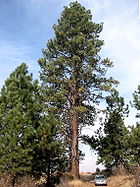 Members of the nuthatch family live in most of North America and Europe and throughout Asia down to the Wallace Line
Members of the nuthatch family live in most of North America and Europe and throughout Asia down to the Wallace Line
. Nuthatches are sparsely represented in Africa; one species lives in a small area of northeastern Algeria and a population of the Eurasian Nuthatch subspecies, S. e. hispaniensis, lives in the mountains of Morocco
. Most species are resident year-round. The only significant migrant is the Red-breasted Nuthatch, which winters widely across North America, deserting the northernmost parts of its breeding range in Canada; it has been recorded as a vagrant in Bermuda
, Iceland
and England.
Most nuthatches are woodland birds and the majority are found in coniferous or other evergreen
forests, although each species has a preference for a particular tree type. The strength of the association varies from the Corsican Nuthatch, which is closely linked with Corsican Pine
, to the catholic habitat of the Eurasian Nuthatch, which prefers deciduous
or mixed woods but breeds in coniferous forests in the north of its extensive range. However, the two species of rock nuthatches are not strongly tied to woodlands: they breed on rocky slopes or cliffs, although both move into wooded areas when not breeding. In parts of Asia where several species occur in the same geographic region, there is often an altitudinal separation in their preferred habitats.
Nuthatches prefer a fairly temperate climate; northern species live near sea level whereas those further south are found in cooler highland habitats. Eurasian and Red-breasted Nuthatches are lowland birds in the north of their extensive ranges, but breed in the mountains further south; for example, Eurasian Nuthatch, which breeds where the July temperature range is 16–27 °C
, is found near sea level in Northern Europe, but between 1,750 and 1,850 m (5,700–6,100 ft) altitude in Morocco. The Velvet-fronted Nuthatch is the sole member of the family which prefers tropical lowland forests.
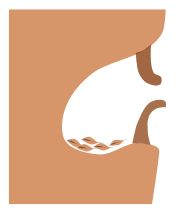 All nuthatches nest in cavities; except for the two species of rock nuthatches, all use tree holes, making a simple cup lined with soft materials on which to rest eggs. In some species the lining consists of small woody objects such as bark flakes and seed husks, while in others it includes the moss, grass, hair and feathers typical of passerine birds.
All nuthatches nest in cavities; except for the two species of rock nuthatches, all use tree holes, making a simple cup lined with soft materials on which to rest eggs. In some species the lining consists of small woody objects such as bark flakes and seed husks, while in others it includes the moss, grass, hair and feathers typical of passerine birds.
Members of the Red-breasted Nuthatch superspecies excavate their own tree holes, although most other nuthatches use natural holes or old woodpecker
nests. Several species reduce the size of the entrance hole and seal up cracks with mud. The Red-breasted Nuthatch makes the nest secure by daubing sticky conifer resin
globules around the entrance, the male applying the resin outside and the female inside. The resin may deter predators or competitors (the resident birds avoid the resin by diving straight through the entrance hole). The White-breasted Nuthatch smears blister beetle
s around the entrance to its nest, and it has been suggested that the unpleasant smell from the crushed insects deters squirrel
s, its chief competitor for natural tree cavities.
The Western Rock Nuthatch builds an elaborate flask-shaped nest from mud, dung and hair or feathers, and decorates the nest's exterior and nearby crevices with feathers and insect wings. The nests are located in rock crevices, in caves, under cliff overhangs or on buildings. The Eastern Rock Nuthatch builds a similar but less complex structure across the entrance to a cavity. Its nest can be quite small but may weigh up to 32 kg
(70 lb
). This species will also nest in river banks or tree holes and will enlarge its nest hole if it the cavity is too small.
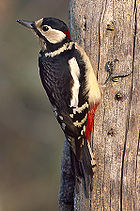 Nuthatches are monogamous
Nuthatches are monogamous
and pair for life. The female produces eggs that are white with red or yellow markings; the clutch size varies, tending to be larger for northern species. The eggs are incubated for 12 to 18 days by the female alone, or by both parents, depending on the species. The altricial
(naked and helpless) chicks take between 21 and 27 days to fledge. Both parents feed the young, and in the case of two American species, Brown-headed and Pygmy, helper
males from the previous brood may assist the parents in feeding.
For the few species on which data are available, the average nuthatch lifespan in the wild is between 2 and 3.5 years, although ages of up to 10 years have been recorded. The Eurasian Nuthatch has an adult annual survival rate
of 53% and the male Corsican Nuthatch 61.6%. Nuthatches and other small woodland birds share the same predators: accipiter
s, owl
s, squirrels and woodpeckers. An American study showed that nuthatch responses to predators may be linked to reproductive strategies. It measured the willingness of males of two species to feed incubating females on the nest when presented with models of a Sharp-shinned Hawk
, which hunts adult nuthatches, or a House Wren
, which destroys eggs. The White-breasted Nuthatch is shorter-lived than the Red-breasted Nuthatch, but has more young, and was found to respond more strongly to the egg predator, whereas the Red-breasted showed greater concern with the hawk. This supports the theory that longer-lived species benefit from adult survival and future breeding opportunities while birds with shorter life spans place more value on the survival of their larger broods.
Cold can be a problem for small birds that do not migrate. Communal roosting in tight huddles can help conserve heat and several nuthatch species employ it—up to 170 Pygmy Nuthatches have been seen in a single roost. The Pygmy Nuthatch is able to lower its body temperature when roosting, conserving energy through hypothermia
and a lowered metabolic rate
.
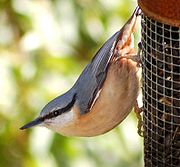 Nuthatches forage along tree trunks and branches and are members of the same feeding guild
Nuthatches forage along tree trunks and branches and are members of the same feeding guild
as woodpeckers. Unlike woodpeckers and treecreepers
, however, they do not use their tails for additional support, relying instead on their strong legs and feet to progress in jerky hops. They are able to descend head-first and hang upside-down beneath twigs and branches. Krüper's Nuthatch can even stretch downward from an upside-down position to drink water from leaves without touching the ground. Rock nuthatches forage with a similar technique to the woodland species, but seek food on rock faces and sometimes buildings. When breeding, a pair of nuthatches will only feed within their territory, but at other times will associate with passing tits or join mixed-species feeding flock
s.
Insect
s and other invertebrate
s are a major portion of the nuthatch diet, especially during the breeding season, when they rely almost exclusively on live prey, but most species also eat seeds during the winter, when invertebrates are less readily available. Larger food items, such as big insects, snail
s, acorn
s or seeds may be wedged into cracks and pounded with the bird's strong bill. Unusually for a bird, the Brown-headed Nuthatch uses a piece of tree bark as a lever to pry up other bark flakes to look for food; the bark tool may then be carried from tree to tree or used to cover a seed cache.
All nuthatches appear to store food, especially seeds, in tree crevices, in the ground, under small stones, or behind bark flakes, and these caches are remembered for as long as 30 days. Similarly, the rock nuthatches wedge snails into suitable crevices for consumption in times of need. European Nuthatches have been found to avoid using their caches during benign conditions in order to save them for harsher times.
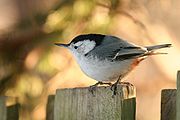 Some nuthatches, such as the Eurasian Nuthatch and the North American species, have extensive ranges and large populations, and few conservation problems, although locally they may be affected by woodland fragmentation. In contrast, some of the more restricted species face severe pressures.
Some nuthatches, such as the Eurasian Nuthatch and the North American species, have extensive ranges and large populations, and few conservation problems, although locally they may be affected by woodland fragmentation. In contrast, some of the more restricted species face severe pressures.
The endangered
White-browed Nuthatch is found only in the Mount Victoria
area of Burma, where forest up to 2,000 m (6,560 ft) above sea level has been almost totally cleared and habitat between 2,000–2,500 m (6,560–8200 ft) is heavily degraded. Nearly 12,000 people live in the Natma Taung national park
which includes Mount Victoria, and their fires and traps add to the pressure on the nuthatch. The population of the White-browed Nuthatch, estimated at only a few thousand, is decreasing, and no conservation measures are in place. The Algerian Nuthatch is found in only four areas of Algeria, and it is possible that the total population does not exceed 1,000 birds. Fire, erosion, and grazing and disturbance by livestock have reduced the quality of the habitat, despite its location in the Taza National Park.
Deforestation has also caused population declines for the vulnerable
Yunnan and Yellow-billed Nuthatches. The Yunnan Nuthatch can cope with some tree loss, since it prefers open pine woodland, but although still locally common, it has disappeared from several of the areas in which it was recorded in the early 20th century. The threat to Yellow-billed is particularly acute on Hainan, where more than 70% of the woodland has been lost in the past 50 years due to shifting cultivation and the use of wood for fuel during Chinese government re-settlement programmes.
Krüper's Nuthatch is threatened by urbanisation and development in and around mature coniferous forests, particularly in the Mediterranean coastal areas where the species was once numerous. A law promoting tourism came into force in Turkey in 2003, further exacerbating the threats to their habitat. The law reduced bureaucracy and made it easier for developers to build tourism facilities and summer houses in the coastal zone where woodland loss is a growing problem for the nuthatch.
Genus
In biology, a genus is a low-level taxonomic rank used in the biological classification of living and fossil organisms, which is an example of definition by genus and differentia...
, Sitta, of small passerine
Passerine
A passerine is a bird of the order Passeriformes, which includes more than half of all bird species. Sometimes known as perching birds or, less accurately, as songbirds, the passerines form one of the most diverse terrestrial vertebrate orders: with over 5,000 identified species, it has roughly...
bird
Bird
Birds are feathered, winged, bipedal, endothermic , egg-laying, vertebrate animals. Around 10,000 living species and 188 families makes them the most speciose class of tetrapod vertebrates. They inhabit ecosystems across the globe, from the Arctic to the Antarctic. Extant birds range in size from...
s belonging to the family Sittidae
Sittidae
Sittidae is a family of small passerine birds which contains the single genus Sitta containing about 24 species of nuthatches, which are found across Eurasia and North America....
. Characterised by large heads, short tails, and powerful bills and feet, nuthatches advertise their territory using loud, simple songs. Most species exhibit grey or bluish upperparts and a black eye stripe.
Most nuthatches breed in the temperate or montane
Montane
In biogeography, montane is the highland area located below the subalpine zone. Montane regions generally have cooler temperatures and often have higher rainfall than the adjacent lowland regions, and are frequently home to distinct communities of plants and animals.The term "montane" means "of the...
woodlands of the Northern Hemisphere
Northern Hemisphere
The Northern Hemisphere is the half of a planet that is north of its equator—the word hemisphere literally means “half sphere”. It is also that half of the celestial sphere north of the celestial equator...
, although two species have adapted to rocky habitats in the warmer and drier regions of Eurasia
Eurasia
Eurasia is a continent or supercontinent comprising the traditional continents of Europe and Asia ; covering about 52,990,000 km2 or about 10.6% of the Earth's surface located primarily in the eastern and northern hemispheres...
. However, the greatest diversity is in Southern Asia, and similarities between the species have made it difficult to identify distinct species. All members of this genus nest in holes or crevices. Most species are non-migratory
Bird migration
Bird migration is the regular seasonal journey undertaken by many species of birds. Bird movements include those made in response to changes in food availability, habitat or weather. Sometimes, journeys are not termed "true migration" because they are irregular or in only one direction...
and live in their habitat year-round, although the North America
North America
North America is a continent wholly within the Northern Hemisphere and almost wholly within the Western Hemisphere. It is also considered a northern subcontinent of the Americas...
n Red-breasted Nuthatch
Red-breasted Nuthatch
The Red-breasted Nuthatch, Sitta canadensis, is a small songbird. The adult has blue-grey upperparts with cinnamon underparts, a white throat and face with a black stripe through the eyes, a straight grey bill and a black crown. Its call, which has been likened to a tin trumpet, is high-pitched...
migrates to warmer regions during the winter. A few nuthatch species have restricted ranges and face threats from deforestation
Deforestation
Deforestation is the removal of a forest or stand of trees where the land is thereafter converted to a nonforest use. Examples of deforestation include conversion of forestland to farms, ranches, or urban use....
.
Nuthatches are omnivorous, eating mostly insect
Insect
Insects are a class of living creatures within the arthropods that have a chitinous exoskeleton, a three-part body , three pairs of jointed legs, compound eyes, and two antennae...
s, nut
Nut (fruit)
A nut is a hard-shelled fruit of some plants having an indehiscent seed. While a wide variety of dried seeds and fruits are called nuts in English, only a certain number of them are considered by biologists to be true nuts...
s and seed
Seed
A seed is a small embryonic plant enclosed in a covering called the seed coat, usually with some stored food. It is the product of the ripened ovule of gymnosperm and angiosperm plants which occurs after fertilization and some growth within the mother plant...
s. They forage for insects hidden in or under bark by climbing along tree trunks and branches, sometimes upside-down. They forage within their territories when breeding, but may join mixed feeding flocks
Mixed-species feeding flock
A mixed-species feeding flock, also termed a mixed-species foraging flock, mixed hunting party or informally bird wave, is a flock of usually insectivorous birds of different species, that join each other and move together while foraging...
at other times. Their habit of wedging a large food item in a crevice and then hacking at it with their strong bills gives this group its English name.
Taxonomy
Nuthatches are all in the genus Sitta (LinnaeusCarolus Linnaeus
Carl Linnaeus , also known after his ennoblement as , was a Swedish botanist, physician, and zoologist, who laid the foundations for the modern scheme of binomial nomenclature. He is known as the father of modern taxonomy, and is also considered one of the fathers of modern ecology...
, 1758), a name derived from sittē, Ancient Greek
Ancient Greek
Ancient Greek is the stage of the Greek language in the periods spanning the times c. 9th–6th centuries BC, , c. 5th–4th centuries BC , and the c. 3rd century BC – 6th century AD of ancient Greece and the ancient world; being predated in the 2nd millennium BC by Mycenaean Greek...
for this bird. Nuthatch refers to the propensity of some species to wedge a large insect or seed in a crack and hack at it with their strong bills.
Some taxonomists place the nuthatches, the Wallcreeper
Wallcreeper
The Wallcreeper is a small passerine bird found throughout the high mountains of Eurasia. It is the only member of the genus Tichodroma.-Taxonomy and etymology:...
and the treecreepers in a larger group with the wren
Wren
The wrens are passerine birds in the mainly New World family Troglodytidae. There are approximately 80 species of true wrens in approximately 20 genera....
s and gnatcatcher
Gnatcatcher
The 15-20 species of small passerine birds in the gnatcatcher family occur in North and South America . Most species of this mainly tropical and subtropical group are resident, but the Blue-gray Gnatcatcher of the USA and southern Canada migrates south in winter...
s. This superfamily
Taxonomic rank
In biological classification, rank is the level in a taxonomic hierarchy. Examples of taxonomic ranks are species, genus, family, and class. Each rank subsumes under it a number of less general categories...
, the Certhioidea, is supported by phylogenetic
Phylogenetics
In biology, phylogenetics is the study of evolutionary relatedness among groups of organisms , which is discovered through molecular sequencing data and morphological data matrices...
studies using mitochondrial and nuclear
Cell nucleus
In cell biology, the nucleus is a membrane-enclosed organelle found in eukaryotic cells. It contains most of the cell's genetic material, organized as multiple long linear DNA molecules in complex with a large variety of proteins, such as histones, to form chromosomes. The genes within these...
DNA, and forms a sister clade
Clade
A clade is a group consisting of a species and all its descendants. In the terms of biological systematics, a clade is a single "branch" on the "tree of life". The idea that such a "natural group" of organisms should be grouped together and given a taxonomic name is central to biological...
of the Sylvioidea
Old World warbler
The "Old World Warblers" is the name used to describe a large group of birds formerly grouped together in the bird family Sylviidae. The family held over 400 species in over 70 genera, and were the source of much taxonomic confusion. Two families were split out initially, the cisticolas into...
within the passerine birds. The fossil record for this group is restricted to a foot bone of an early Miocene
Miocene
The Miocene is a geological epoch of the Neogene Period and extends from about . The Miocene was named by Sir Charles Lyell. Its name comes from the Greek words and and means "less recent" because it has 18% fewer modern sea invertebrates than the Pliocene. The Miocene follows the Oligocene...
bird from Bavaria
Bavaria
Bavaria, formally the Free State of Bavaria is a state of Germany, located in the southeast of Germany. With an area of , it is the largest state by area, forming almost 20% of the total land area of Germany...
, Certhiops rummeli, which has been identified as an extinct member of the Certhioidea clade.
Species boundaries in the nuthatches are difficult to define. The Red-breasted Nuthatch, Corsican Nuthatch
Corsican Nuthatch
The Corsican Nuthatch, Sitta whiteheadi, is a small passerine bird which is endemic to Corsica, where it is the only nuthatch.The Corsican Nuthatch is a resident bird of the mountain forests of Corsica, and is closely associated with Corsican Pine preferably with some very old trees aged 300 years...
and Chinese Nuthatch have breeding ranges separated by thousands of kilometres, but are similar in habitat preference, appearance and song. They were formerly considered to be one species, but are now normally split into three and comprise a superspecies
Superspecies
A superspecies is a group of at least two more or less distinctive species with approximately parapatric distributions. Not all species complexes, whether cryptices or ring species are superspecies, and vice versa, but many are...
along with the Krüper's
Krüper's Nuthatch
The Krüper's Nuthatch, Sitta krueperi, is a small nuthatch. The name commemorates the German naturalist Theodor Johannes Krüper.thumb|left|Illustration by [[Joseph Wolf]], 1865-Distribution and habitat:...
and Algerian Nuthatch
Algerian Nuthatch
The Algerian Nuthatch, Sitta ledanti, is a small passerine bird which is the only bird species endemic to Algeria, where it is also the only nuthatch. It was first discovered in 1973....
. Unusually for nuthatches, all five species excavate their own nests. The Eurasian
Eurasian Nuthatch
The Eurasian Nuthatch, Sitta europaea, is a small passerine found throughout temperate Europe and Asia, although not in Ireland. It belongs to the nuthatch family Sittidae....
, Chestnut-vented
Chestnut-vented Nuthatch
The Chestnut-vented Nuthatch is a species of bird in the Sittidae family. It is found in Bangladesh, China, India, Laos, Myanmar, Thailand, and Vietnam....
, Kashmir
Kashmir Nuthatch
The Kashmir Nuthatch is a species of bird in the Sittidae family. It is found in Afghanistan, India, Nepal, and Pakistan....
and Chestnut-bellied Nuthatch
Chestnut-bellied Nuthatch
The Indian Nuthatch is a species of bird in the Sittidae family. It is found in India.Its natural habitats are subtropical or tropical dry forests, subtropical or tropical moist lowland forests, and subtropical or tropical moist montanes.This species has been split by Rasmussen and Anderton from...
es form another superspecies and replace each other geographically across Asia. They are currently considered to be four separate species, but the south-Asian forms were once believed to be a subspecies of the Eurasian Nuthatch. A recent proposed change in this taxonomy is a split of the Chestnut-bellied Nuthatch into two species, namely the Indian Nuthatch, Sitta castanea, found south of the Ganges, and the Chestnut-bellied Nuthatch sensu strictu, S. cinnamoventris, which occurs in the Himalayas
Himalayas
The Himalaya Range or Himalaya Mountains Sanskrit: Devanagari: हिमालय, literally "abode of snow"), usually called the Himalayas or Himalaya for short, is a mountain range in Asia, separating the Indian subcontinent from the Tibetan Plateau...
.
The Nuthatch Vanga
Nuthatch Vanga
The Nuthatch Vanga , also known as the Coral-billed Nuthatch-vanga and formerly as the Coral-billed Nuthatch, is a species of bird in the Vangidae family.It is endemic to Madagascar....
of Madagascar
Madagascar
The Republic of Madagascar is an island country located in the Indian Ocean off the southeastern coast of Africa...
(formerly known as the Coral-billed Nuthatch) and the sitella
Sitella
The sittellas are a family, Neosittidae, of small passerine birds found only in Australasia. They resemble nuthatches, but whilst they were considered to be in that family for many years they are now afforded their own family...
s from Australia
Australia
Australia , officially the Commonwealth of Australia, is a country in the Southern Hemisphere comprising the mainland of the Australian continent, the island of Tasmania, and numerous smaller islands in the Indian and Pacific Oceans. It is the world's sixth-largest country by total area...
and New Guinea
New Guinea
New Guinea is the world's second largest island, after Greenland, covering a land area of 786,000 km2. Located in the southwest Pacific Ocean, it lies geographically to the east of the Malay Archipelago, with which it is sometimes included as part of a greater Indo-Australian Archipelago...
were once placed in the nuthatch family because of similarities in appearance and lifestyle, but they are not closely related. The resemblances arose via convergent evolution
Convergent evolution
Convergent evolution describes the acquisition of the same biological trait in unrelated lineages.The wing is a classic example of convergent evolution in action. Although their last common ancestor did not have wings, both birds and bats do, and are capable of powered flight. The wings are...
to fill an ecological
Ecology
Ecology is the scientific study of the relations that living organisms have with respect to each other and their natural environment. Variables of interest to ecologists include the composition, distribution, amount , number, and changing states of organisms within and among ecosystems...
niche.
A 2006 review of Asian nuthatches suggested that there are still unresolved problems in nuthatch taxonomy and proposed splitting the genus Sitta. This suggestion would move the red- and yellow-billed south Asian species (Velvet-fronted
Velvet-fronted Nuthatch
The Velvet-fronted Nuthatch, Sitta frontalis, is a small passerine bird found in southern Asia from Pakistan, India and Sri Lanka east to south China and Indonesia...
, Yellow-billed
Yellow-billed Nuthatch
The Yellow-billed Nuthatch is a species of bird in the Sittidae family. It is found in China, Laos, and Vietnam.Its natural habitats are subtropical or tropical moist lowland forests and subtropical or tropical moist montanes. It is threatened by habitat loss.-References:* BirdLife International...
and Sulphur-billed Nuthatch
Sulphur-billed Nuthatch
The Sulphur-billed Nuthatch is a species of bird in the Sittidae family. It is endemic to the Philippines.Its natural habitats are subtropical or tropical moist lowland forests and subtropical or tropical moist montanes....
es) to a new genus, create a third genus for the Blue Nuthatch
Blue Nuthatch
The Blue Nuthatch is a species of bird in the Sittidae family. It is found in Indonesia and Malaysia.Its natural habitats are subtropical or tropical moist lowland forests and subtropical or tropical moist montanes.-References:...
, and possibly a fourth for the Beautiful Nuthatch
Beautiful Nuthatch
The Beautiful Nuthatch is one of the rarest nuthatches on Earth. It occurs in north east India and neighbouring regions, with odd records across to Thailand, where it may be a winter visitor or resident....
. Mitochondrial DNA studies have demonstrated that the white-breasted northern subspecies of Eurasian Nuthatch, S. (europea) arctica, is distinctive and also a possible candidate for full species status.
Description

Supercilium
The supercilium is a plumage feature found on the heads of some bird species. It is a stripe which runs from the base of the bird's beak above its eye, finishing somewhere towards the rear of the bird's head. Also known as an "eyebrow", it is distinct from the eyestripe, which is a line which runs...
, dark forehead and blackish cap is common. The sexes look similar, but may differ in underpart colouration, especially on the rear flanks and under the tail. Juveniles and first-year birds can be almost indistinguishable from adults.
The sizes of nuthatches vary, from the large Giant Nuthatch, at 195 mm (7.75 in) and 36–47 g
Gram
The gram is a metric system unit of mass....
(1.3–1.6 oz
Ounce
The ounce is a unit of mass with several definitions, the most commonly used of which are equal to approximately 28 grams. The ounce is used in a number of different systems, including various systems of mass that form part of the imperial and United States customary systems...
), to the small Brown-headed Nuthatch and the Pygmy Nuthatch, both around 100 mm (4 in) in length and about 10 g (0.36 oz).
Nuthatches are very vocal, using an assortment of whistles, trills and calls. Their breeding songs tend to be simple and often identical to their contact calls but longer in duration. The Red-breasted Nuthatch, which coexists with the Black-capped Chickadee
Black-capped Chickadee
The Black-capped Chickadee is a small, North American songbird, a passerine bird in the tit family Paridae. It is the state bird of both Maine and Massachusetts in the United States, and the provincial bird of New Brunswick in Canada...
throughout much of its range, is able to understand the latter species' calls. The chickadee has subtle call variations that communicate information about the size and risk of potential predators. Many birds recognise the simple alarm calls produced by other species, but the Red-breasted Nuthatch is able to interpret the chickadees' detailed variations and to respond appropriately.
Species
The species diversity for Sittidae is greatest in southern Asia (possibly the original home of this family), where about 15 species occur, but it has representatives across much of the Northern Hemisphere. The currently recognised nuthatch species are tabulated below.| Species in taxonomic sequence Taxonomic sequence Taxonomic sequence is a sequence followed in listing of taxa which aids ease of use and roughly reflects the evolutionary relationships among the taxa... |
|||
|---|---|---|---|
| Common and binomial names |
Image | Description | Range (population if known) |
| Eurasian Nuthatch Eurasian Nuthatch The Eurasian Nuthatch, Sitta europaea, is a small passerine found throughout temperate Europe and Asia, although not in Ireland. It belongs to the nuthatch family Sittidae.... (Sitta europaea) |
_-modified.jpg) |
14 cm (5.5 in) long, black eye stripe, blue-grey upper parts, reddish and/or white underparts depending on subspecies. | Temperate Eurasia Eurasia Eurasia is a continent or supercontinent comprising the traditional continents of Europe and Asia ; covering about 52,990,000 km2 or about 10.6% of the Earth's surface located primarily in the eastern and northern hemispheres... (10 million) |
| Chestnut-vented Nuthatch Chestnut-vented Nuthatch The Chestnut-vented Nuthatch is a species of bird in the Sittidae family. It is found in Bangladesh, China, India, Laos, Myanmar, Thailand, and Vietnam.... (Sitta nagaensis) |
 |
12.5–14 cm (5–5.5 in) long, mostly pale grey upper parts and mostly whitish underparts, dark eye stripe. | Northeast India India India , officially the Republic of India , is a country in South Asia. It is the seventh-largest country by geographical area, the second-most populous country with over 1.2 billion people, and the most populous democracy in the world... east to northwest Thailand Thailand Thailand , officially the Kingdom of Thailand , formerly known as Siam , is a country located at the centre of the Indochina peninsula and Southeast Asia. It is bordered to the north by Burma and Laos, to the east by Laos and Cambodia, to the south by the Gulf of Thailand and Malaysia, and to the... |
| Kashmir Nuthatch Kashmir Nuthatch The Kashmir Nuthatch is a species of bird in the Sittidae family. It is found in Afghanistan, India, Nepal, and Pakistan.... (Sitta cashmirensis) |
 |
14 cm (5.5 in) long, mostly greyish upper parts, reddish underparts with a paler throat and chin. | Eastern Afghanistan Afghanistan Afghanistan , officially the Islamic Republic of Afghanistan, is a landlocked country located in the centre of Asia, forming South Asia, Central Asia and the Middle East. With a population of about 29 million, it has an area of , making it the 42nd most populous and 41st largest nation in the world... to western Nepal Nepal Nepal , officially the Federal Democratic Republic of Nepal, is a landlocked sovereign state located in South Asia. It is located in the Himalayas and bordered to the north by the People's Republic of China, and to the south, east, and west by the Republic of India... |
| Chestnut-bellied Nuthatch Chestnut-bellied Nuthatch The Indian Nuthatch is a species of bird in the Sittidae family. It is found in India.Its natural habitats are subtropical or tropical dry forests, subtropical or tropical moist lowland forests, and subtropical or tropical moist montanes.This species has been split by Rasmussen and Anderton from... (Sitta cinnamoventris)) |
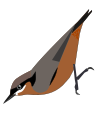 |
13 cm (5.25 in) long, colours vary between the subspecies. | Foothills of the Himalayas from northeast India to western Yunnan Yunnan Yunnan is a province of the People's Republic of China, located in the far southwest of the country spanning approximately and with a population of 45.7 million . The capital of the province is Kunming. The province borders Burma, Laos, and Vietnam.Yunnan is situated in a mountainous area, with... and Thailand. |
| Indian Nuthatch (Sitta castanea) |
 |
13 cm (5.25 in) long, colours vary between the subspecies. | Northern and central India. |
| White-tailed Nuthatch White-tailed Nuthatch The White-tailed Nuthatch is a species of bird in the Sittidae family. It is found in Bhutan, China, India, Laos, Myanmar, Nepal, and Vietnam.-Description and ecology:... (Sitta himalayensis) |
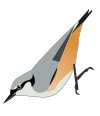 |
12 cm (4.75 in) long, smaller bill than S. cashmirensis, rufous-orange underparts with unmarked bright rufous undertail-coverts, white on the upper tail coverts is difficult to see in the field. | Himalayas Himalayas The Himalaya Range or Himalaya Mountains Sanskrit: Devanagari: हिमालय, literally "abode of snow"), usually called the Himalayas or Himalaya for short, is a mountain range in Asia, separating the Indian subcontinent from the Tibetan Plateau... from northeast India to southwest China China Chinese civilization may refer to:* China for more general discussion of the country.* Chinese culture* Greater China, the transnational community of ethnic Chinese.* History of China* Sinosphere, the area historically affected by Chinese culture... , locally east to Vietnam Vietnam Vietnam – sometimes spelled Viet Nam , officially the Socialist Republic of Vietnam – is the easternmost country on the Indochina Peninsula in Southeast Asia. It is bordered by China to the north, Laos to the northwest, Cambodia to the southwest, and the South China Sea –... |
| White-browed Nuthatch White-browed Nuthatch The White-browed Nuthatch is a species of bird in the nuthatch family. It is endemic to Burma. Its natural habitat is subtropical or tropical moist montane forests.... (Sitta victoriae) |
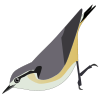 |
11.5 cm (4.5 in) long, greyish upper parts and mostly whitish underparts. | Endemic to Burma. |
| Pygmy Nuthatch Pygmy Nuthatch The Pygmy Nuthatch is a tiny songbird, about 10 cm long and about 10 grams in weight. It ranges from southern British Columbia south through various discontinuous parts of the western U.S. , to central Mexico... (Sitta pygmaea) |
_at_a_feeder.jpg) |
10 cm (4 in) long, grey cap, blue-grey upper parts, whitish underparts, whitish spot on the nape. | Western North America from British Columbia British Columbia British Columbia is the westernmost of Canada's provinces and is known for its natural beauty, as reflected in its Latin motto, Splendor sine occasu . Its name was chosen by Queen Victoria in 1858... to southwest Mexico Mexico The United Mexican States , commonly known as Mexico , is a federal constitutional republic in North America. It is bordered on the north by the United States; on the south and west by the Pacific Ocean; on the southeast by Guatemala, Belize, and the Caribbean Sea; and on the east by the Gulf of... (2.3 million) |
| Brown-headed Nuthatch Brown-headed Nuthatch The Brown-headed Nuthatch, Sitta pusilla, is a small songbird found in pine forests throughout the Southeastern United States. An endangered population occurs in the pineyards of Grand Bahama; some authorities consider it to represent a separate species, S. insularis... (Sitta pusilla) |
 |
10.5 cm (4 in) long, brown cap with narrow black eye stripe and buff white cheeks, chin, and belly, wings are bluish-grey, small white spot at the nape of the neck. | Southeast United States and the Bahamas The Bahamas The Bahamas , officially the Commonwealth of the Bahamas, is a nation consisting of 29 islands, 661 cays, and 2,387 islets . It is located in the Atlantic Ocean north of Cuba and Hispaniola , northwest of the Turks and Caicos Islands, and southeast of the United States... (1.5 million) |
| Corsican Nuthatch Corsican Nuthatch The Corsican Nuthatch, Sitta whiteheadi, is a small passerine bird which is endemic to Corsica, where it is the only nuthatch.The Corsican Nuthatch is a resident bird of the mountain forests of Corsica, and is closely associated with Corsican Pine preferably with some very old trees aged 300 years... (Sitta whiteheadi) |
 |
12 cm (4.75 in) long, blue-grey above, and buff below. Male has a black crown and eye stripe separated by a white supercilium Supercilium The supercilium is a plumage feature found on the heads of some bird species. It is a stripe which runs from the base of the bird's beak above its eye, finishing somewhere towards the rear of the bird's head. Also known as an "eyebrow", it is distinct from the eyestripe, which is a line which runs... ; the female has a grey crown and eye stripe. |
Endemic to Corsica Corsica Corsica is an island in the Mediterranean Sea. It is located west of Italy, southeast of the French mainland, and north of the island of Sardinia.... (3,000–9,000 pairs) |
| Algerian Nuthatch Algerian Nuthatch The Algerian Nuthatch, Sitta ledanti, is a small passerine bird which is the only bird species endemic to Algeria, where it is also the only nuthatch. It was first discovered in 1973.... (Sitta ledanti) |
 |
13.5 cm (5.5 in) long, blue-grey above, and buff below. Male has a black crown and eye stripe separated by a white supercilium; female has a grey crown and eye stripe. | Endemic to northeast Algeria Algeria Algeria , officially the People's Democratic Republic of Algeria , also formally referred to as the Democratic and Popular Republic of Algeria, is a country in the Maghreb region of Northwest Africa with Algiers as its capital.In terms of land area, it is the largest country in Africa and the Arab... (Fewer than 1,000 pairs) |
| Krüper's Nuthatch Krüper's Nuthatch The Krüper's Nuthatch, Sitta krueperi, is a small nuthatch. The name commemorates the German naturalist Theodor Johannes Krüper.thumb|left|Illustration by [[Joseph Wolf]], 1865-Distribution and habitat:... (Sitta krueperi) |
 |
11.5–12.5 cm (4.5–5 in) long, whitish underparts with a reddish throat, mostly grey upper parts. | Turkey Turkey Turkey , known officially as the Republic of Turkey , is a Eurasian country located in Western Asia and in East Thrace in Southeastern Europe... , Georgia Georgia (country) Georgia is a sovereign state in the Caucasus region of Eurasia. Located at the crossroads of Western Asia and Eastern Europe, it is bounded to the west by the Black Sea, to the north by Russia, to the southwest by Turkey, to the south by Armenia, and to the southeast by Azerbaijan. The capital of... , Russia Russia Russia or , officially known as both Russia and the Russian Federation , is a country in northern Eurasia. It is a federal semi-presidential republic, comprising 83 federal subjects... and on the Greek Greece Greece , officially the Hellenic Republic , and historically Hellas or the Republic of Greece in English, is a country in southeastern Europe.... island of Lesvos Lesbos Island Lesbos is a Greek island located in the northeastern Aegean Sea. It has an area of with 320 kilometres of coastline, making it the third largest Greek island. It is separated from Turkey by the narrow Mytilini Strait.... . (80,000–170,000 pairs) |
| Snowy-browed Nuthatch Snowy-browed Nuthatch The Snowy-browed Nuthatch is a species of bird in the Sittidae family. It is found in China, North Korea, and South Korea.Its natural habitat is temperate forests.-References:... or Chinese Nuthatch (Sitta villosa) |
 |
11.5 cm (4.25 in) long, greyish upper parts and pinkish underparts. | China, North Korea, and South Korea |
| Yunnan Nuthatch Yunnan Nuthatch The Yunnan Nuthatch is a species of bird in the Sittidae family. It is endemic to China .Its natural habitat is subtropical or tropical dry forests. It is becoming rare due to habitat loss.-Source:... (Sitta yunnanensis) |
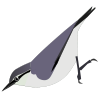 |
12 cm (4.75 in) long, greyish upper parts and whitish underparts. | Endemic to southwest China |
| Red-breasted Nuthatch Red-breasted Nuthatch The Red-breasted Nuthatch, Sitta canadensis, is a small songbird. The adult has blue-grey upperparts with cinnamon underparts, a white throat and face with a black stripe through the eyes, a straight grey bill and a black crown. Its call, which has been likened to a tin trumpet, is high-pitched... (Sitta canadensis) |
10-4c.jpg) |
11 cm (4 in) long, blue-grey upper parts, with reddish underparts, white face with a black eye stripe, white throat, a straight grey bill and a black crown. | Western and northern temperate North America, winters across much of the US and southern Canada Canada Canada is a North American country consisting of ten provinces and three territories. Located in the northern part of the continent, it extends from the Atlantic Ocean in the east to the Pacific Ocean in the west, and northward into the Arctic Ocean... (18 million) |
| White-cheeked Nuthatch White-cheeked Nuthatch The White-cheeked Nuthatch is a species of bird in the Sittidae family. It is found in Afghanistan, Bhutan, China, India, Nepal, and Pakistan.Its natural habitats are boreal forests and temperate forests.-References:... (Sitta leucopsis) |
 |
13 cm (5 in) long, white cheeks, chin, throat, and underparts, upper parts mostly dark grey. | Eastern Afghanistan to western Nepal and western China (10 million) |
| White-breasted Nuthatch White-breasted Nuthatch The White-breasted Nuthatch is a small songbird of the nuthatch family which breeds in old-growth woodland across much of temperate North America. It is a stocky bird, with a large head, short tail, powerful bill and strong feet. The upperparts are pale blue-gray, and the face and underparts are... (Sitta carolinensis) |
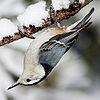 |
13–14 cm (5–6 in) long, the white of the face completely surrounds the eye, face and the underparts are white, upper parts are mostly pale blue-grey. | North America from southern Canada to Mexico |
| Western Rock Nuthatch Western Rock Nuthatch The Western Rock Nuthatch, Sitta neumayer is a small passerine bird which breeds from Serbia east through Greece and Turkey to Iran. This nuthatch is largely resident apart from some post-breeding dispersal... (Sitta neumayer) |
 |
13.5 cm (5.5 in) long. white throat and underparts shading to buff on the belly. The shade of grey upper parts and the darkness of the eye stripe vary between the three subspecies. | The Balkans Balkans The Balkans is a geopolitical and cultural region of southeastern Europe... east through Greece Greece Greece , officially the Hellenic Republic , and historically Hellas or the Republic of Greece in English, is a country in southeastern Europe.... and Turkey Turkey Turkey , known officially as the Republic of Turkey , is a Eurasian country located in Western Asia and in East Thrace in Southeastern Europe... to Iran Iran Iran , officially the Islamic Republic of Iran , is a country in Southern and Western Asia. The name "Iran" has been in use natively since the Sassanian era and came into use internationally in 1935, before which the country was known to the Western world as Persia... (130,000) |
| Eastern Rock Nuthatch Eastern Rock Nuthatch The Persian Nuthatch or the Eastern Rock-nuthatch is a species of bird in the Sittidae family. It is found in Afghanistan, Armenia, Azerbaijan, Georgia, India, Iran, Iraq, Kazakhstan, Pakistan, Russia, Tajikistan, Turkey, and Turkmenistan.-References:* BirdLife International 2004. . ... (Sitta tephronota) |
 |
16–18 cm (6.25–7 in) long, greyish upper parts and whitish underparts, pinkish rump. | Northern Iraq Iraq Iraq ; officially the Republic of Iraq is a country in Western Asia spanning most of the northwestern end of the Zagros mountain range, the eastern part of the Syrian Desert and the northern part of the Arabian Desert.... and western Iran east through Central Asia Central Asia Central Asia is a core region of the Asian continent from the Caspian Sea in the west, China in the east, Afghanistan in the south, and Russia in the north... (43,000–100,000 in Europe) |
| Velvet-fronted Nuthatch Velvet-fronted Nuthatch The Velvet-fronted Nuthatch, Sitta frontalis, is a small passerine bird found in southern Asia from Pakistan, India and Sri Lanka east to south China and Indonesia... (Sitta frontalis) |
2-2008-11-07.jpg) |
12.5 cm (5 in) long, violet-blue above, with lavender cheeks, beige underparts and a whitish throat, bill is red, black patch on forehead. | India and Sri Lanka Sri Lanka Sri Lanka, officially the Democratic Socialist Republic of Sri Lanka is a country off the southern coast of the Indian subcontinent. Known until 1972 as Ceylon , Sri Lanka is an island surrounded by the Indian Ocean, the Gulf of Mannar and the Palk Strait, and lies in the vicinity of India and the... through Southeast Asia Southeast Asia Southeast Asia, South-East Asia, South East Asia or Southeastern Asia is a subregion of Asia, consisting of the countries that are geographically south of China, east of India, west of New Guinea and north of Australia. The region lies on the intersection of geological plates, with heavy seismic... to Indonesia Indonesia Indonesia , officially the Republic of Indonesia , is a country in Southeast Asia and Oceania. Indonesia is an archipelago comprising approximately 13,000 islands. It has 33 provinces with over 238 million people, and is the world's fourth most populous country. Indonesia is a republic, with an... |
| Yellow-billed Nuthatch Yellow-billed Nuthatch The Yellow-billed Nuthatch is a species of bird in the Sittidae family. It is found in China, Laos, and Vietnam.Its natural habitats are subtropical or tropical moist lowland forests and subtropical or tropical moist montanes. It is threatened by habitat loss.-References:* BirdLife International... (Sitta solangiae) |
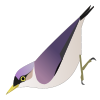 |
12.5–13.5 cm (5–5.5 in) long, white underparts, bluish upper parts, yellow beak. | Vietnam and Hainan Island, China |
| Sulphur-billed Nuthatch Sulphur-billed Nuthatch The Sulphur-billed Nuthatch is a species of bird in the Sittidae family. It is endemic to the Philippines.Its natural habitats are subtropical or tropical moist lowland forests and subtropical or tropical moist montanes.... (Sitta oenochlamys) |
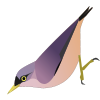 |
12.5 cm (5 in) long, pinkish underparts, yellow beak, bluish upper parts. | Endemic to the Philippines Philippines The Philippines , officially known as the Republic of the Philippines , is a country in Southeast Asia in the western Pacific Ocean. To its north across the Luzon Strait lies Taiwan. West across the South China Sea sits Vietnam... |
| Blue Nuthatch Blue Nuthatch The Blue Nuthatch is a species of bird in the Sittidae family. It is found in Indonesia and Malaysia.Its natural habitats are subtropical or tropical moist lowland forests and subtropical or tropical moist montanes.-References:... (Sitta azurea) |
 Click here for video |
13.5 cm (5.25 in) long, greyish upper parts and whitish underparts. | Malaysia, Sumatra Sumatra Sumatra is an island in western Indonesia, westernmost of the Sunda Islands. It is the largest island entirely in Indonesia , and the sixth largest island in the world at 473,481 km2 with a population of 50,365,538... and Java Java Java is an island of Indonesia. With a population of 135 million , it is the world's most populous island, and one of the most densely populated regions in the world. It is home to 60% of Indonesia's population. The Indonesian capital city, Jakarta, is in west Java... |
| Giant Nuthatch Giant Nuthatch The Giant Nuthatch is a species of bird in the Sittidae family. It is found in China, Myanmar, and Thailand.Its natural habitat is subtropical or tropical dry forests. It is threatened by habitat loss. In northern Thailand they were found to use Pinus kesiya stands both for foraging as well as for... (Sitta magna) |
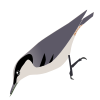 . . |
19.5 cm (7.75 in) long, greyish upper parts and whitish underparts. | China, Burma, and Thailand. |
| Beautiful Nuthatch Beautiful Nuthatch The Beautiful Nuthatch is one of the rarest nuthatches on Earth. It occurs in north east India and neighbouring regions, with odd records across to Thailand, where it may be a winter visitor or resident.... (Sitta formosa) |
 |
16.5 cm (6.5 in) long, black-backed with white streaking, bright blue upper back, rump and shoulders, dull orange underparts and paler face. | Northeast India and Burma and locally in southern China and northern Southeast Asia |
Distribution and habitat

Wallace Line
The Wallace Line separates the ecozones of Asia and Wallacea, a transitional zone between Asia and Australia. West of the line are found organisms related to Asiatic species; to the east, a mixture of species of Asian and Australian origin is present...
. Nuthatches are sparsely represented in Africa; one species lives in a small area of northeastern Algeria and a population of the Eurasian Nuthatch subspecies, S. e. hispaniensis, lives in the mountains of Morocco
Morocco
Morocco , officially the Kingdom of Morocco , is a country located in North Africa. It has a population of more than 32 million and an area of 710,850 km², and also primarily administers the disputed region of the Western Sahara...
. Most species are resident year-round. The only significant migrant is the Red-breasted Nuthatch, which winters widely across North America, deserting the northernmost parts of its breeding range in Canada; it has been recorded as a vagrant in Bermuda
Bermuda
Bermuda is a British overseas territory in the North Atlantic Ocean. Located off the east coast of the United States, its nearest landmass is Cape Hatteras, North Carolina, about to the west-northwest. It is about south of Halifax, Nova Scotia, Canada, and northeast of Miami, Florida...
, Iceland
Iceland
Iceland , described as the Republic of Iceland, is a Nordic and European island country in the North Atlantic Ocean, on the Mid-Atlantic Ridge. Iceland also refers to the main island of the country, which contains almost all the population and almost all the land area. The country has a population...
and England.
Most nuthatches are woodland birds and the majority are found in coniferous or other evergreen
Evergreen
In botany, an evergreen plant is a plant that has leaves in all seasons. This contrasts with deciduous plants, which completely lose their foliage during the winter or dry season.There are many different kinds of evergreen plants, both trees and shrubs...
forests, although each species has a preference for a particular tree type. The strength of the association varies from the Corsican Nuthatch, which is closely linked with Corsican Pine
European Black Pine
Pinus nigra, the European Black Pine, is a moderately variable species of pine, occurring across southern Mediterranean Europe from Spain to the Crimea, in Asia Minor and on Cyprus, and in the high mountains of the Maghreb in North Africa....
, to the catholic habitat of the Eurasian Nuthatch, which prefers deciduous
Deciduous
Deciduous means "falling off at maturity" or "tending to fall off", and is typically used in reference to trees or shrubs that lose their leaves seasonally, and to the shedding of other plant structures such as petals after flowering or fruit when ripe...
or mixed woods but breeds in coniferous forests in the north of its extensive range. However, the two species of rock nuthatches are not strongly tied to woodlands: they breed on rocky slopes or cliffs, although both move into wooded areas when not breeding. In parts of Asia where several species occur in the same geographic region, there is often an altitudinal separation in their preferred habitats.
Nuthatches prefer a fairly temperate climate; northern species live near sea level whereas those further south are found in cooler highland habitats. Eurasian and Red-breasted Nuthatches are lowland birds in the north of their extensive ranges, but breed in the mountains further south; for example, Eurasian Nuthatch, which breeds where the July temperature range is 16–27 °C
Celsius
Celsius is a scale and unit of measurement for temperature. It is named after the Swedish astronomer Anders Celsius , who developed a similar temperature scale two years before his death...
, is found near sea level in Northern Europe, but between 1,750 and 1,850 m (5,700–6,100 ft) altitude in Morocco. The Velvet-fronted Nuthatch is the sole member of the family which prefers tropical lowland forests.
Nesting, breeding and survival

Members of the Red-breasted Nuthatch superspecies excavate their own tree holes, although most other nuthatches use natural holes or old woodpecker
Woodpecker
Woodpeckers are near passerine birds of the order Piciformes. They are one subfamily in the family Picidae, which also includes the piculets and wrynecks. They are found worldwide and include about 180 species....
nests. Several species reduce the size of the entrance hole and seal up cracks with mud. The Red-breasted Nuthatch makes the nest secure by daubing sticky conifer resin
Resin
Resin in the most specific use of the term is a hydrocarbon secretion of many plants, particularly coniferous trees. Resins are valued for their chemical properties and associated uses, such as the production of varnishes, adhesives, and food glazing agents; as an important source of raw materials...
globules around the entrance, the male applying the resin outside and the female inside. The resin may deter predators or competitors (the resident birds avoid the resin by diving straight through the entrance hole). The White-breasted Nuthatch smears blister beetle
Blister beetle
Blister beetles are beetles of the family Meloidae, so called for their defensive secretion of a blistering agent, cantharidin. There are approximately 7,500 known species worldwide. Many are conspicuous and some aposematically colored, announcing their toxicity to would-be...
s around the entrance to its nest, and it has been suggested that the unpleasant smell from the crushed insects deters squirrel
Squirrel
Squirrels belong to a large family of small or medium-sized rodents called the Sciuridae. The family includes tree squirrels, ground squirrels, chipmunks, marmots , flying squirrels, and prairie dogs. Squirrels are indigenous to the Americas, Eurasia, and Africa and have been introduced to Australia...
s, its chief competitor for natural tree cavities.
The Western Rock Nuthatch builds an elaborate flask-shaped nest from mud, dung and hair or feathers, and decorates the nest's exterior and nearby crevices with feathers and insect wings. The nests are located in rock crevices, in caves, under cliff overhangs or on buildings. The Eastern Rock Nuthatch builds a similar but less complex structure across the entrance to a cavity. Its nest can be quite small but may weigh up to 32 kg
Kilogram
The kilogram or kilogramme , also known as the kilo, is the base unit of mass in the International System of Units and is defined as being equal to the mass of the International Prototype Kilogram , which is almost exactly equal to the mass of one liter of water...
(70 lb
Pound (mass)
The pound or pound-mass is a unit of mass used in the Imperial, United States customary and other systems of measurement...
). This species will also nest in river banks or tree holes and will enlarge its nest hole if it the cavity is too small.

Monogamy
Monogamy /Gr. μονός+γάμος - one+marriage/ a form of marriage in which an individual has only one spouse at any one time. In current usage monogamy often refers to having one sexual partner irrespective of marriage or reproduction...
and pair for life. The female produces eggs that are white with red or yellow markings; the clutch size varies, tending to be larger for northern species. The eggs are incubated for 12 to 18 days by the female alone, or by both parents, depending on the species. The altricial
Altricial
Altricial, meaning "requiring nourishment", refers to a pattern of growth and development in organisms which are incapable of moving around on their own soon after hatching or being born...
(naked and helpless) chicks take between 21 and 27 days to fledge. Both parents feed the young, and in the case of two American species, Brown-headed and Pygmy, helper
Helpers at the nest
Helpers at the nest is a term used in behavioural ecology and evolutionary biology to describe a social structure in which juveniles and sexually mature adolescents of either one or both sexes, remain in association with their parents and help them raise subsequent broods or litters, instead of...
males from the previous brood may assist the parents in feeding.
For the few species on which data are available, the average nuthatch lifespan in the wild is between 2 and 3.5 years, although ages of up to 10 years have been recorded. The Eurasian Nuthatch has an adult annual survival rate
Survival rate
In biostatistics, survival rate is a part of survival analysis, indicating the percentage of people in a study or treatment group who are alive for a given period of time after diagnosis...
of 53% and the male Corsican Nuthatch 61.6%. Nuthatches and other small woodland birds share the same predators: accipiter
Accipiter
The genus Accipiter is a group of birds of prey in the family Accipitridae, many of which are named as goshawks and sparrowhawks. They can be anatomically distinguished from their relatives by the lack of a procoracoid foramen. Two small and aberrant species usually placed here do possess a large...
s, owl
Owl
Owls are a group of birds that belong to the order Strigiformes, constituting 200 bird of prey species. Most are solitary and nocturnal, with some exceptions . Owls hunt mostly small mammals, insects, and other birds, although a few species specialize in hunting fish...
s, squirrels and woodpeckers. An American study showed that nuthatch responses to predators may be linked to reproductive strategies. It measured the willingness of males of two species to feed incubating females on the nest when presented with models of a Sharp-shinned Hawk
Sharp-shinned Hawk
The Sharp-shinned Hawk is a small hawk. In fact, "sharp-shins" or "sharpies" are the smallest to reside in USA and Canada, though some Neotropical species are smaller...
, which hunts adult nuthatches, or a House Wren
House Wren
The House Wren, Troglodytes aedon, is a very small songbird of the wren family, Troglodytidae. It occurs from Canada to southernmost South America, and is thus the most widely distributed bird in the Americas. It occurs in most suburban areas in its range and it is the single most common wren...
, which destroys eggs. The White-breasted Nuthatch is shorter-lived than the Red-breasted Nuthatch, but has more young, and was found to respond more strongly to the egg predator, whereas the Red-breasted showed greater concern with the hawk. This supports the theory that longer-lived species benefit from adult survival and future breeding opportunities while birds with shorter life spans place more value on the survival of their larger broods.
Cold can be a problem for small birds that do not migrate. Communal roosting in tight huddles can help conserve heat and several nuthatch species employ it—up to 170 Pygmy Nuthatches have been seen in a single roost. The Pygmy Nuthatch is able to lower its body temperature when roosting, conserving energy through hypothermia
Hypothermia
Hypothermia is a condition in which core temperature drops below the required temperature for normal metabolism and body functions which is defined as . Body temperature is usually maintained near a constant level of through biologic homeostasis or thermoregulation...
and a lowered metabolic rate
Basal metabolic rate
Basal Metabolic Rate , and the closely related resting metabolic rate , is the amount of daily energy expended by humans and other animals at rest. Rest is defined as existing in a neutrally temperate environment while in the post-absorptive state...
.
Feeding

Guild (ecology)
A guild is any group of species that exploit the same resources, often in related ways. As can be seen from the list of examples below, it does not follow that the species within a guild occupy the same, or even similar, ecological niches...
as woodpeckers. Unlike woodpeckers and treecreepers
Certhia
Certhia is the genus of birds containing the typical treecreepers, which together with the Spotted Creeper make up the family Certhiidae.The typical treecreepers occur in many wooded parts of the North Temperate Zone...
, however, they do not use their tails for additional support, relying instead on their strong legs and feet to progress in jerky hops. They are able to descend head-first and hang upside-down beneath twigs and branches. Krüper's Nuthatch can even stretch downward from an upside-down position to drink water from leaves without touching the ground. Rock nuthatches forage with a similar technique to the woodland species, but seek food on rock faces and sometimes buildings. When breeding, a pair of nuthatches will only feed within their territory, but at other times will associate with passing tits or join mixed-species feeding flock
Mixed-species feeding flock
A mixed-species feeding flock, also termed a mixed-species foraging flock, mixed hunting party or informally bird wave, is a flock of usually insectivorous birds of different species, that join each other and move together while foraging...
s.
Insect
Insect
Insects are a class of living creatures within the arthropods that have a chitinous exoskeleton, a three-part body , three pairs of jointed legs, compound eyes, and two antennae...
s and other invertebrate
Invertebrate
An invertebrate is an animal without a backbone. The group includes 97% of all animal species – all animals except those in the chordate subphylum Vertebrata .Invertebrates form a paraphyletic group...
s are a major portion of the nuthatch diet, especially during the breeding season, when they rely almost exclusively on live prey, but most species also eat seeds during the winter, when invertebrates are less readily available. Larger food items, such as big insects, snail
Snail
Snail is a common name applied to most of the members of the molluscan class Gastropoda that have coiled shells in the adult stage. When the word is used in its most general sense, it includes sea snails, land snails and freshwater snails. The word snail without any qualifier is however more often...
s, acorn
Acorn
The acorn, or oak nut, is the nut of the oaks and their close relatives . It usually contains a single seed , enclosed in a tough, leathery shell, and borne in a cup-shaped cupule. Acorns vary from 1–6 cm long and 0.8–4 cm broad...
s or seeds may be wedged into cracks and pounded with the bird's strong bill. Unusually for a bird, the Brown-headed Nuthatch uses a piece of tree bark as a lever to pry up other bark flakes to look for food; the bark tool may then be carried from tree to tree or used to cover a seed cache.
All nuthatches appear to store food, especially seeds, in tree crevices, in the ground, under small stones, or behind bark flakes, and these caches are remembered for as long as 30 days. Similarly, the rock nuthatches wedge snails into suitable crevices for consumption in times of need. European Nuthatches have been found to avoid using their caches during benign conditions in order to save them for harsher times.
Status

The endangered
Endangered species
An endangered species is a population of organisms which is at risk of becoming extinct because it is either few in numbers, or threatened by changing environmental or predation parameters...
White-browed Nuthatch is found only in the Mount Victoria
Nat Ma Taung
Nat Ma Taung , is the highest mountain in the Chin State of western Burma. Located in Kanpalet Township, Mindat District, Mount Victoria is part of the Chin Hills range, and rises to above sea level....
area of Burma, where forest up to 2,000 m (6,560 ft) above sea level has been almost totally cleared and habitat between 2,000–2,500 m (6,560–8200 ft) is heavily degraded. Nearly 12,000 people live in the Natma Taung national park
National park
A national park is a reserve of natural, semi-natural, or developed land that a sovereign state declares or owns. Although individual nations designate their own national parks differently A national park is a reserve of natural, semi-natural, or developed land that a sovereign state declares or...
which includes Mount Victoria, and their fires and traps add to the pressure on the nuthatch. The population of the White-browed Nuthatch, estimated at only a few thousand, is decreasing, and no conservation measures are in place. The Algerian Nuthatch is found in only four areas of Algeria, and it is possible that the total population does not exceed 1,000 birds. Fire, erosion, and grazing and disturbance by livestock have reduced the quality of the habitat, despite its location in the Taza National Park.
Deforestation has also caused population declines for the vulnerable
Vulnerable species
On 30 January 2010, the IUCN Red List of Threatened Species identified 9694 Vulnerable species, subspecies and varieties, stocks and sub-populations.-References:...
Yunnan and Yellow-billed Nuthatches. The Yunnan Nuthatch can cope with some tree loss, since it prefers open pine woodland, but although still locally common, it has disappeared from several of the areas in which it was recorded in the early 20th century. The threat to Yellow-billed is particularly acute on Hainan, where more than 70% of the woodland has been lost in the past 50 years due to shifting cultivation and the use of wood for fuel during Chinese government re-settlement programmes.
Krüper's Nuthatch is threatened by urbanisation and development in and around mature coniferous forests, particularly in the Mediterranean coastal areas where the species was once numerous. A law promoting tourism came into force in Turkey in 2003, further exacerbating the threats to their habitat. The law reduced bureaucracy and made it easier for developers to build tourism facilities and summer houses in the coastal zone where woodland loss is a growing problem for the nuthatch.

